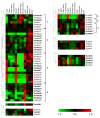Genome-Wide Identification and Spatial Expression Analysis of Histone Modification Gene Families in the Rubber Dandelion Taraxacum kok-saghyz
- PMID: 36015381
- PMCID: PMC9415798
- DOI: 10.3390/plants11162077
Genome-Wide Identification and Spatial Expression Analysis of Histone Modification Gene Families in the Rubber Dandelion Taraxacum kok-saghyz
Abstract
Taraxacum kok-saghyz (Tks), also known as the Russian dandelion, is a recognized alternative source of natural rubber quite comparable, for quality and use, to the one obtained from the so-called rubber tree, Hevea brasiliensis. In addition to that, Tks roots produce several other compounds, including inulin, whose use in pharmaceutical and dietary products is quite extensive. Histone-modifying genes (HMGs) catalyze a series of post-translational modifications that affect chromatin organization and conformation, which, in turn, regulate many downstream processes, including gene expression. In this study, we present the first analysis of HMGs in Tks. Altogether, we identified 154 putative Tks homologs: 60 HMTs, 34 HDMs, 42 HATs, and 18 HDACs. Interestingly, whilst most of the classes showed similar numbers in other plant species, including M. truncatula and A. thaliana, HATs and HMT-PRMTs were indeed more abundant in Tks. Composition and structure analysis of Tks HMG proteins showed, for some classes, the presence of novel domains, suggesting a divergence from the canonical HMG model. The analysis of publicly available transcriptome datasets, combined with spatial expression of different developmental tissues, allowed us to identify several HMGs with a putative role in metabolite biosynthesis. Overall, our work describes HMG genomic organization and sets the premises for the functional characterization of epigenetic modifications in rubber-producing plants.
Keywords: Taraxacum kok-saghyz; gene expression; histone modification; natural rubber.
Conflict of interest statement
The authors declare no conflict of interest.
Figures







References
-
- Sharifi-Rad M., Roberts T.H., Matthews K.R., Bezerra C.F., Morais-Braga M.F.B., Coutinho H.D.M., Sharopov F., Salehi B., Yousaf Z., Sharifi-Rad M., et al. Ethnobotany of the Genus Taraxacum—Phytochemicals and Antimicrobial Activity. Phytother. Res. 2018;32:2131–2145. doi: 10.1002/ptr.6157. - DOI - PubMed
-
- Kirschner J., Štěpánek J., Černý T., De Heer P., van Dijk P.J. Available Ex Situ Germplasm of the Potential Rubber Crop Taraxacum Koksaghyz Belongs to a Poor Rubber Producer, T. Brevicorniculatum (Compositae-Crepidinae) Genet. Resour. Crop Evol. 2013;60:455–471. doi: 10.1007/s10722-012-9848-0. - DOI

